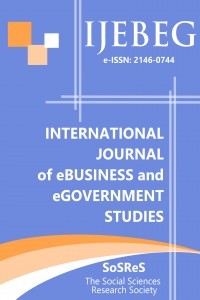AN ASSESSMENT OF THE VALUE OF PMI AND MANUFACTURING SECTOR GROWTH IN PREDICTING OVERALL ECONOMIC OUTPUT (GDP) IN SOUTH AFRICA
AN ASSESSMENT OF THE VALUE OF PMI AND MANUFACTURING SECTOR GROWTH IN PREDICTING OVERALL ECONOMIC OUTPUT (GDP) IN SOUTH AFRICA
ARDL, Economic output MPI, South Africa,
___
- Altissimo, F., Cristadoro, R., Forni, M., Lippi, M. & Veronese, G. (2010). New Eurocoin: Tracking economic growth in real time. The Review of Economics and Statistics, 92(4), 1024-1034.
- Aprigliano, V. (2011). The relationship between the PMI and the Italian index of industrial production and the impact of the latest economic crisis. http://docplayer.net/38084361-Temi-di-discussione-the-relationship-between-the-pmi-and-the-italian-index-of-industrial-production-and-the-impact-of-the-latest-economic-crisis.html. Accessed 2018/06/15.
- Banerjee, A., Dolado, J. & Mestre, R. (1998). Error-correction mechanism tests for cointegration in a single equation framework. Journal of Time Series Analysis, 19(3), 267–283.
- Barnes, R. (2017). Economic indicators: Purchasing managers index (PMI). https://www.coursehero.com/file/5894246/EconomicIndicators/. Accessed 2018/06/14.
- Bayer, C. & Hanck, C. (2013). Combining non-cointegration tests. Journal of Time Series Analysis, 34(1), 83–95.
- BER. (2015). PMI: A monthly index of business conditions in the manufacturing sector. https://10513086/Downloads/BER%20pmi_pdf_absa.pdf. Accessed 2018/06/12.
- Boswijk, H.P. (1994). Testing for an unstable root in conditional and structural error correction models. Journal of Econometrics, 63(1), 37-60.
- Chien, Y. & Morris, P. (2016). PMI and GDP: Do they correlate for the united States? For China? Economic Synopses, Issue 6, pp. 1-2, 2016. SSRN: https://ssrn.com/abstract=2756951. Accessed 2018/06/05.
- Chin, H. (2017). PMI Report on China manufacturing. https://www.funggroup.com/eng/knowledge/research/PMI_november13.pdf. Accessed 2018/06/04.
- Engle, R.F. & Granger, C.W. (1987). Co-integration and error correction: Representation, estimation and testing. Econometrica: Journal of the Econometric Society, 55(2), 251–276.
- Harris, E.S. (1991). Tracking the economy with the purchasing manager’s index. Washington, DC. Federal Reserve Bank.
- Haug, A. (2002). Temporal aggregation and the power of cointegration tests: A Monte Carlo study. Oxford Bulletin of Economics and Statistics, 64, 399–412.
- Johansen, S. (1991). Estimation and hypothesis testing of cointegration vectors in Gaussian vector autoregressive model. Econometrica: Journal of the Econometric Society, 59(6), 1551–1580.
- Joseph, A., Larrain, M. & Turnerc, C. (2011). Forecasting purchasing managers’ index with compressed interest rates and past values. Procedia Computer Science, 6, 213-218.
- IHS Markit. (2017). Interpreting PMI data. https://www.markiteconomics.com/survey/pdf.mvc/en_pmirecruitment. Accessed 2018/06/08.
- Khundrakpam, J.K. & George, A.T. (2013). An empirical analysis of the relationship between WPI and PMI-manufacturing price indices in India. https://ideas.repec.org/p/pra/mprapa/50929.html. Accessed 2018/06/07.
- Koenig, E.F. (2002). Using the purchasing managers’ index to assess the economy’s strength and the likely direction of monetary policy. Federal Reserve Bank of Dallas, Economic and Financial Policy Review, 1(6), 1-14.
- Lahiri, K. & Monokroussos, G. (2013). Nowcasting US GDP: The role of ISM business surveys. International Journal of Forecasting, 29(4), 644-658.
- Laurenceson, J. & Chai, J.C.H. (2003). Financial reform and economic development in China. Cheltenham, UK: Edward Elgar.
- Lindsey, M.D. & Pavur, R. (2005), As the PMI turns: A tool for supply chain managers. The Journal of Supply Chain Management, 41(3), 30-39.
- Narayan, P.K. (2005). The saving and investment nexus for China: Evidence from cointegration tests. Applied Economics, 37, 1979–1990. Pelaez, R.F. (2003). A reassessment of the purchasing managers' index. Business Economics, 38(4), 35-42.
- Pesaran, M.H., Shin, Y. & Smith, R.J. (2001). Bounds testing approaches to the analysis of level relationships. Journal of Applied Econometrics, 16(3), 289–326.
- Phillips, P.C. & Ouliaris, S. (1990). Asymptotic properties of residual-based tests for cointegration. Econometrica: Journal of Econometric Society, 58(1), 165–193.
- Tsuchiya, Y. (2012). Is the purchasing managers’ index useful for assessing the economy’s strength? A directional analysis. Economics Bulletin, 32(2), 1302-1311.
- Başlangıç: 2009
- Yayıncı: Sosyal Bilimler Araştırmaları Derneği
AGRICULTURAL PRODUCTION IN SOUTH AFRICA: INFORMATION AND COMMUNICATION TECHNOLOGY (ICT) SPILLOVER
Oladipo Olalekan DAVİD, Wynand GROBLER
Daniel Francois MEYER, Thomas HABANABAKİZE
A COMPARATIVE ANALYSIS OF E-GOVERNMENT SERVICES OF CROTIA, POLAND AND TURKEY
Zafer KILIÇ, Vildan ATEŞ, Aleksandar ERCEG, Sebastian JABLONSKI
Abdirashid Ali ADLE, Ömür AKDEMİR
OCCUPATIONAL HEALTH AND WORK SAFETY SYSTEMS IN COMPLIANCE WITH INDUSTRY 4.0: RESEARCH DIRECTIONS
WEBSITE USAGE IN DIGITAL PUBLIC RELATIONS – AN ANALYSIS OF IT COMPANIES IN TURKEY
E-COMMERCE IN TURKEY AND SAP INTEGRATED E-COMMERCE SYSTEM
AN INVESTIGATION INTO SUSTAINABLE SUPPLY CHAIN MANAGEMENT PRACTICES IN A DEVELOPING COUNTRY
